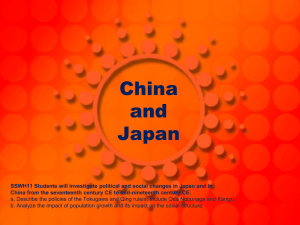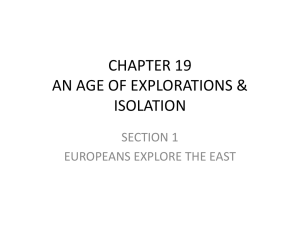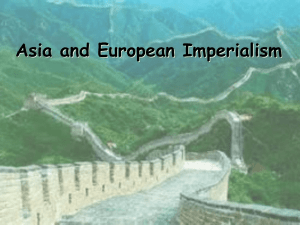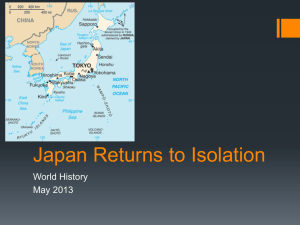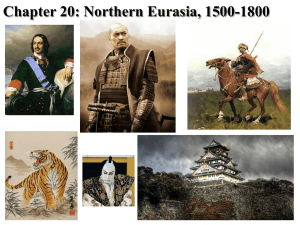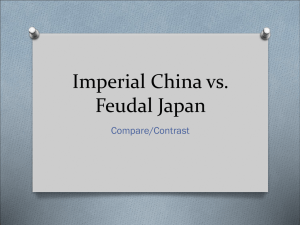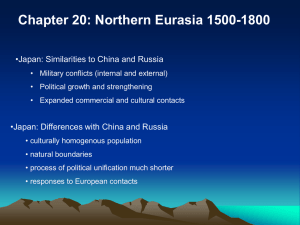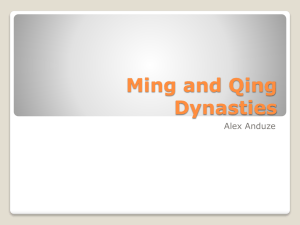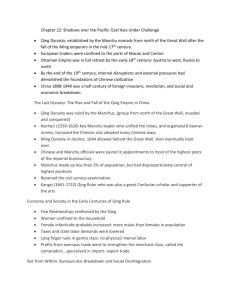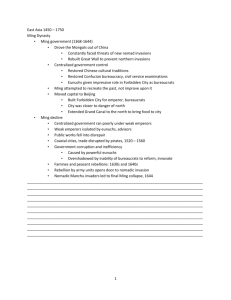CHAPTER 17 The East Asian World
advertisement
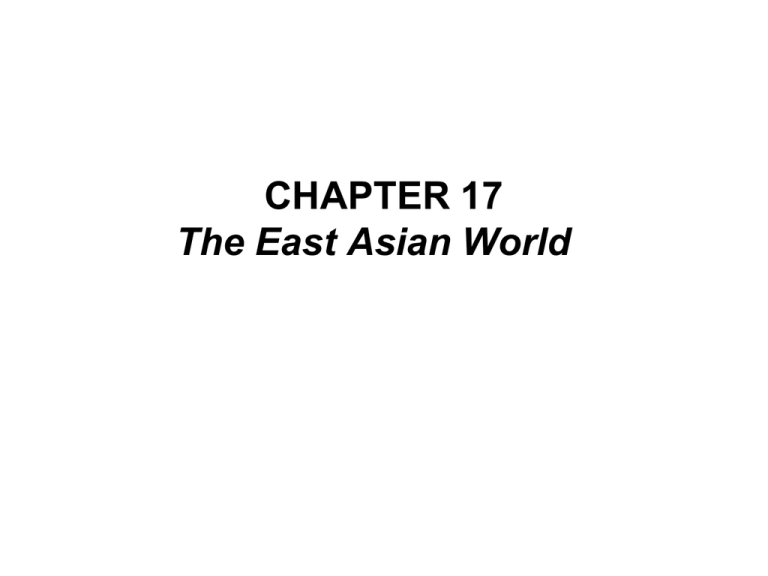
CHAPTER 17 The East Asian World China at its Apex • Why were the Manchu’s so successful at establishing a foreign dynasty in China? • What were the main characteristics of Manchu Rule? • Banners • Dyarchy Ming Dynasty (1369 – 1644) • Reign of Kublai Khan ended 1368 • Zhu Yuanzhang – Peasant rebellion – Period of expansion – Zheng He (1405-1433) • Portuguese Contact – Permitted to Occupy Macao – Direct trade limited – Strong Jesuit Influence 16th C Decline of Ming • Factors – Weak rulers – Era of corruption – concentration of land – English & Dutch disrupted silver trade – Decline of economy – decline of crop yields – Starvation & Epidemic – Peasant Rebellion • LiZicheng, occupied Beijing China and Its Enemies During the Late Ming Era Qing Dynasty (1644-1911) • Manchu's & Ming Military assumed the rebellion founded the Qing in 1644 • The Reign of Kangxi (1661-1722) • Stabilized imperial rule by pacifying the northern and western frontiers • Made the empire acceptable to the general public • Active patron of arts and letters – Supported scholars through projects • Western missionaries were permitted to be active Emperor Kangxi The Era of Peace & Prosperity © Hu Weibiao/Panorama/The Image Works Signs of Internal decay • The Reign of Qianlong (1736-1795) • Military overextended • Corrupt subordinates exploited their position • Court corruption, siphoned off imperial funds to family or favorites • Led to unrest in rural areas (higher taxes, pressure on land, population increase) – White Lotus Rebellion (1796-1804) was suppressed at great imperial expense Qing Politics • Factors of success for the Manchu's – Ability to adapt to new environment – Retained Ming Political system – Established legitimacy as rightful rulers by stressing their devotion to the principles of Confucianism Qing Politics • Factors of conflict? – Ethnically, linguistically and culturally different from subjects • Tried to protect unique identity (2% of population) • Legally defined as distinct from everyone else • Banners (stationed as separate units in various strategic positions throughout china) the bannerman were the primary fighting force of the empire • Dyarchy – all important administrative positions were shared equally by Chinese and Manchu's The Qing Empire in the Eighteenth Century Rise of European Dominance • End of the 17th C English became the dominant force in European trade – East Indian Company • trading unit and administrator of English territories • First trading post in Canton in 1699 Canton in the Eighteenth Century European Warehouses at Canton •End of the 18th C England demanded they be allowed access to other cities along the coast and that the country be opened up to manufactured goods. © The Art Archive/Marine Museum, Stockholm, Sweden/Gianni Dagli Orti Changing China • How did the economy and society change during the Ming and Qing eras? • To what degree did these changes seem to be leading toward an industrial revolution on the European Model? Social & Economic Changes • The Population explosion – During Ming and Qing 70-80 million in 1390 • Era of peace and stability under early Qing • Introduction of new crops – peanuts, sweet potatoes, maize • New species of faster growing rice • Seed of industrialization • Steady growth of manufacturing and commerce • Commercial networks began to operate regionally and nationally. • Exports outpaced imports Role of Women • Daily Life in Qing China – Subordinate to men • • • • Secluded and virtuous (Spanish observation) Could not divorce or inherit property He could divorce her if she produced no male heirs Patriarchal privilege: second wife or concubine for pleasure • Widows if they remarried , the in laws would inherit all of her previous property and original dowry • Female sacrifice & infanticide Tokugawa Japan • How did the society and economy of Japan change during the Tokugawa era? • How did Japanese culture reflect those changes? • Fudai Daimyo • Tozama Daimyo • Ronin The Three Great Unifiers • Oda Nobunaga & Toyotomi Hideyoshi – generals attempted to seize control and expand their rule. • Tokugawa Leyasu • named himself Shogun in 1603 • Most powerful and long lasting of all • Tokugawa rulers completed the restoration of central authority that previous rulers had begun. Tokugawa Japan Open to western trade & religion Restricted after missionaries acquired territory & used force to convert The Tokugawa “Great Peace” • Characteristics of Administration – Centralized Rule – Shogun ruled through Bakufu (coalition of Daimyo & council of elders – Shogunate’s dual role • Set national policy on behalf of Emp. Kyoto • Governed Shoguns domain • Domains or Han ruled by 250 Daimyo – Fudai (inside Daimyo subordinate to Shogun) – Tozama (Outside Daimyo, independent) Changes in Hierarchy • Daimyo- supported by taxes on their lands • Dual residence, family stayed in Edo to ensure their loyalty to the Shogunate – Reliance on rice cultivation - debt • Samurai Class size limited, ceased to be a warrior class but maintained class distinction Seeds of Capitalism • Rise in commerce and manufacturing • Tech advances in agriculture and expansion of arable land • Commercial expansion took place in major cities and castle towns for the most part – Merchants and artisans lived with samurai • Banking & paper currency • Merchants guilds established Beneficiaries of Changes • Emergence of a merchant Class – Played a significant role in the life of the nation – Early indigenous form of capitalism Non-beneficiaries of Changes • Samurai – barred from commercial activities – Fell into debt – “masterless samurai” or Ronin • Farmers – rice cultivation saw rising cost of living and decrease in profits – Transition to tenancy or wage labor – Peasant revolts Rigid Patriarchal Caste society • Intermarriage between classes not permitted – (warriors, artisans, peasant and merchant) • Eta –outcastes of society – Hereditary Status – Ruled by discriminatory laws • (where they could live, how they could dress and wear their hair) Role of Women (Upper class) • Women became more restricted than previous • (Confucian ideals more prominent in samurai class) • Patriarchs had broad authority over property, marriage, divorce – Wives were expected to obey on pain of death – Males took concubines or homosexual partners (Females were expected to remain chaste) Role of Women (lower class) • Women valued as child bearers and homemakers • Both sexes worked in the fields • Coeducational schools (25% students female) • Infant daughters put to death or sold into prostitution (poor families) • patrilocal marriage • If she did not meet expectations –she would be divorced Cultural Reflections of Change • Popular literature written for townspeople (urban fiction) – Five women who loved love by Saikaku – Homosexual liaisons among the samurai • Kabuki – the rise of the theater Korea & Vietnam • To what degree did developments in Korea during this period reflect conditions in China and Japan? • What were the unique aspects of Vietnamese civilization? • Yangban • Chonmin Similarities to Japan • Entry into the bureaucracy was restricted to members of the aristocratic class – (Yangban “two Groups” civilian and military classes) • Peasants remained in serf like conditions – worked on government estates or manors – Chonmin – class of slaves • served on government plantations • occupations such as butchers and entertainers (beneath dignity of the population) Changes • 15th C phonetic alphabet (Hangul) – Allowed for private correspondence and published fiction for popular audience • A rising commercial class began to displace the Yangban began to blur class distinction – (some became merchants, others peasants as the rising commercial class grew in power and strength) Dai Viet (Vietnam) • Isolated from maritime routes – Peripherally involved in the spice trade – Did not lose territory to European colonial powers • Followed an imperial path of its own – Expanded into the state of Champa to the south and into Old Angkor (Cambodia) – 17th C civil war split Dai Viet into two territories • Beginning of European involvement
